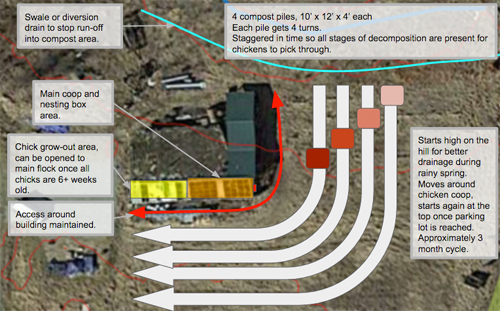Compost Chicken System: Difference between revisions
Jump to navigation
Jump to search

(replaced video with a much better one) |
No edit summary |
||
| Line 10: | Line 10: | ||
==Videos== | ==Videos== | ||
Interview with Karl Hammer: | |||
<html> | |||
<iframe width="420" height="315" src="https://www.youtube.com/embed/Q-Qtd2vGrgM" frameborder="0" allowfullscreen></iframe> | |||
</html> | |||
Video from Vermont Compost: | |||
<html> | <html> | ||
<iframe width="560" height="315" src="https://www.youtube.com/embed/ItgggjRjsQM" frameborder="0" allowfullscreen></iframe> | <iframe width="560" height="315" src="https://www.youtube.com/embed/ItgggjRjsQM" frameborder="0" allowfullscreen></iframe> | ||
Revision as of 14:43, 23 July 2016

Building on the work of compost connoisseur Karl Hammer and permaculture educator Geoff Lawton, we’ll be testing whether a small farm can run a profitable egg enterprise by feeding chickens on local food wastes, producing compost as a by-product. Details of the system are published here on this page.
Chickens can be fed on worms, bugs, food waste and forage alone. This can eliminate the need for grain purchases entirely. Please have a look at the approach that Karl Hammer of Vermont Compost has taken.
Typical Economics
- A buck per chicken, indicating that the industry standard is a loss leader - [1]
- Dressing percentage for heritage chicken is 68-70% - [2]
Videos
Interview with Karl Hammer:
Video from Vermont Compost:
Internal Links
- Most relevant: Compost Chicken on Steroids with Geoff Lawton
- Chicken
- Chicken Market Research
- Fertilized Chicken Eggs
- Automatic Chicken Door
- Top Heritage Chicken Breeds for Meat
- Agriculture Log
More information: grain-free eggs
- OSE Blog April 2016: "Introducing a New Distributive Enterprise: Grain-Free Eggs and Aquaponic Greens"
- Treehugger: "How to grow chickens without buying grain"